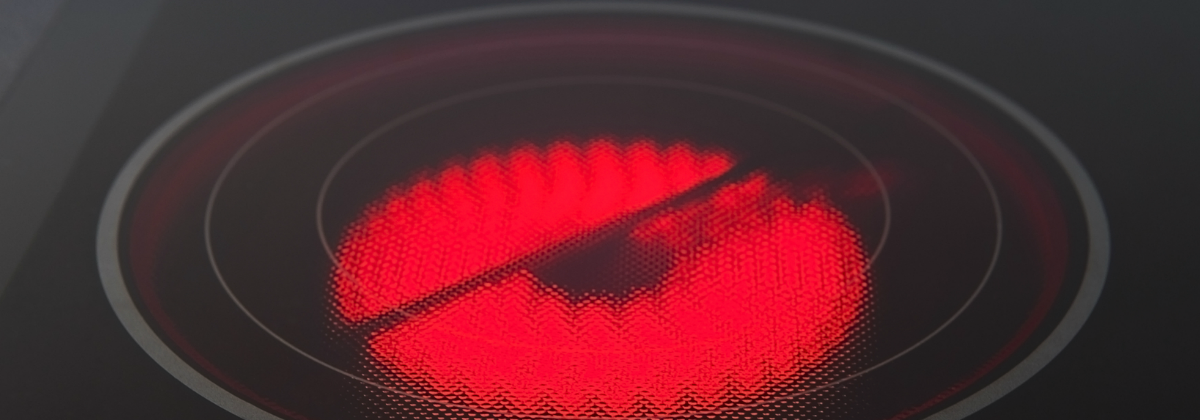Key points
- Electric stovetops work by heating a coil or plate to provide consistent heat at adjustable settings.
- There are important safety protocols for electric stovetops such as not leaving any cloths or tea towels on the hotplates and ensuring the stovetop is turned off when not in use.
- Types of electric stovetops include electric coil, solid hotplates, ceramic and induction.
Gas and electric stoves and cooktops both have their benefits and drawbacks. Ultimately which one you prefer is a matter of personal preference. If you’re considering changing to an electric stovetop or you’re moving somewhere that has one, it might be useful to review how to use them most effectively. Read on with Canstar Blue.
How do electric stoves work?
Simply put, an electric stove top works by running electricity through a circuit, heating a coil or plate. The more you turn it up the dial, the hotter the stove top becomes. The coil protrudes on older stove tops and glows orange when hot. Newer, flat ceramic glass-top stoves instead have an internal element which lights red over the heated area.
How to cook on an electric stove
Electric stoves are generally a cheaper option to buy and install than a gas stove, though they are usually more expensive to operate. Electric stoves are also safer than gas stoves as there isn’t the risk of potential gas leaks or open flames.
Operating an electric stovetop is very simple – turn the dial or press the symbols to adjust to your desired temperature and start cooking. That’s all there is to it. Once set, your stove will provide a steady, constant heat until you switch it to the off position. Electric cooktops are usually easier to clean than gas ones as well, as they have no gas outlets to accidentally clog.
One thing to keep in mind, however, is that electric heating elements take quite a while to heat up and cool down compared to gas elements. Even if the stove looks like it’s off, it can still be quite hot. This also means that you can’t just turn off the burner and leave the pot without continuing to cook the food for some time. If you want to stop cooking, you also need to move the pot or pan to an off burner or another heat safe surface.
Understanding stove temperature settings
Stove settings vary between models and brands, so understanding the temperatures on your own stove before cooking is essential. Some stoves have a dial with four settings: Simmer, low, medium and high. Other stovetops instead have a dial with a near complete circle around the knob that increases in thickness to indicate higher cooking temperatures. If you have a ceramic or induction cooktop, you may not have tactile buttons or knobs at all, instead you could have plus and minus symbols that use a numbered system to indicate heat levels. Make sure to check your user manual if you’re not sure, but here is a general guide:
- Simmer [50˚- 80˚]: Best used to keep food warm.
- Low [80˚ – 100˚ ]: Ideal for retaining moisture when cooking. Great for eggs, stir fry and seafood.
- Medium [100˚ – 150˚]: Medium setting can be used to cook most foods including vegetables and meat.
- High setting [150˚ – 260˚]: This is the best option for red meat or ground meat. It of course poses the highest risk of burning, so keep an eye on your food.
Cooktop safety basics
The elements on cooktops can reach extremely high temperatures. This creates potential for burns and kitchen fires, so exercise caution when cooking.
- Do not leave tea towels or cloths near the stove and ensure curtains are well clear.
- Ensure pot and pan handles are not hanging off the side of the bench as this makes it easier for the cookware to be knocked.
- Try not to lean over heated elements.
- Ensure the stovetop is switched off when not in use.
Why choose an electric stove?
Electric stoves are becoming increasingly common in Australian kitchens, and for good reason. They are a convenient and reliable alternative to gas stoves. That said, electric stoves are not without drawbacks, some of which we’ve listed below.
| Pros | Cons |
|---|---|
| Appliance and installation cheaper than gas stoves | Electricity rates usually higher than gas rates. Possibly costing more in the long run. |
| Easier to clean than gas stoves | Not as responsive and accurate as gas stoves |
Types of electric stoves
Electric coil cooktop
The chances are that you’ve seen electric coil cooktops somewhere in Australia. It’s the traditional stove top usually with four exterior coil elements. What it lacks in aesthetic appeal, it makes up for with practicality, serving as a great all round cooktop.
Solid hotplate
Solid hot plates can provide a slightly more consistent heat than the electric coils, however, they usually take a little longer to heat up and cool down.
Ceramic cooktop
Ceramic cooktops are principally identical to plate or coil cooktops. The key difference is that ceramic cooktops blend seamlessly with the kitchen bench as the coil or plate elements are beneath a strong layer of ceramic glass. Ceramic cooktops are, however, generally more expensive than coil cooktops.
Induction cooktops
Induction cooktops don’t work like coil or hotplate models, instead they use magnetic fields to essentially turn the cookware into the element itself. This provides a high degree of control and cooking consistency. As you might expect, the main downside is that these cooktops are generally the most expensive on the market. Additionally, induction cooktops are only compatible with Ferrous based cookware.
What is the best stove?
Canstar Blue rates and reviews a range of products, including kitchen cooking appliances such as ovens, fridges and dishwashers. While we haven’t yet reviewed electric stove tops individually, you can see which brands dominate the kitchen using our customer satisfaction ratings.
Original Author: Jared Mullane




Share this article